After a few faulty starts, entrepreneur Elon Musk’s Space-X finally became the first private company to launch a cargo ship into orbit last month. But what has taken real rocket science is coming up with the right product and technology to make Musk’s other firm, Tesla Motors, a viable competitor in the hotly competitive auto industry.
After running up losses off more than $750 million since its founding in 2003, the Silicon Valley start-up will launch a product arguably even more important than the Space-X Dragon cargo ship. The 2013 Tesla Model-S will be the firm’s first mainstream passenger car and quite likely its make-it-or-break-it attempt to crack a market dominated by multinational giants like General Motors, Toyota Motor Co. and Daimler AG.
“If it delivers on its promises – not only in sales volume, but also in quality and reliability – the S will propel Tesla into the black and provide working capital to develop of the next line of Tesla vehicles,” said green car analyst John Odell, of the automotive data firm Edmunds.
But Musk and company have made some big promises – with relatively little history to show they can deliver.
The South African-born executive made his fortune as one of the founders of PayPal. He has used the billions he got for selling that company to fund what some skeptics might call a series of fantasies. In a conversation with TheDetroitBureau.com, Musk revealed he has been fascinated with both space flight and with electric propulsion since his childhood. PayPal made it possible for him to enter both fields simultaneously.
After a series of initial failures, Space-X finally succeeded in launching the Dragon capsule into orbit, docking with the International Space Station and safely returning the ship to earth. The company will now move ahead with a NASA contract while working on plans to develop a manned version of the Dragon.
Tesla, meanwhile, is already working up plans for an array of products, including the Model X crossover set for introduction next year. But first, it has to convince a skeptical public that they want the 5-seat Model S, which carries a starting price of $49,900 – after a buyer receives a $7,500 federal tax credit.
That’s a big “if.”
Electric vehicles have been around for over a century. Henry Ford’s wife Clara preferred an electric runabout to her husband’s dirtier Model T, and Ford had hoped his friend and legendary inventor Thomas Edison might come up with a long-range battery that might make the electric vehicle more competitive. He failed, and so have generations of inventors to follow.
Even the most advanced lithium-ion batteries still carry only about 1% of the energy of a comparable mass of gasoline. The Nissan Leaf, the first modern battery-electric vehicle from a major manufacturer contains 24 kilowatt-hours of LiON cells onboard, or the equivalent of about two-thirds of a gallon of petrol, according to the EPA. The federal agency calculates a gallon is equal to 33.7 kWh.
The Leaf, like most of its new competitors – such as the Ford Focus Electric, the Mitsubishi i-MiEV and the upcoming Toyota RAV4-EV – can carry only enough batteries to get between 75 and 100 miles per charge, a key factor in customer rejection, according to industry analysts.
All told, battery-electric vehicles, or BEVs, as well as plug-in hybrids that increase range by adding a back-up gasoline motor, accounted for less than 25,000 U.S. sales last year. And while manufacturers have been projecting substantial growth this year, that hasn’t materialized during the first five months of 2012. Leaf sales have actually slowed, while the Chevrolet Volt plug-in’s are up, but not nearly enough to meet a 45,000-unit target.
“We firmly expect that the electric-car sales rate will continues (to) rise, though it will be slow,” Tesla’s Musk acknowledged in a recently published blog posting.
Tesla has targeted sales of 5,000 Model S sedans during this launch year, with volumes expected to double in 2013. It claims that 10,000 customers have already plunked down refundable deposits.
That would be a significant improvement from the total of just 2,150 2-seat Roadsters Tesla has sold since 2008. But the original battery-car was as much publicity stunt as proof-of-concept, helping generate headlines, especially when high-profile customers like actor-cum-activist George Clooney drove off in one.
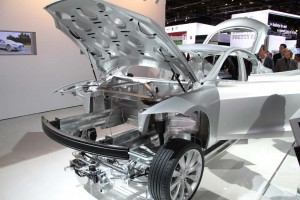
A skeleton of the Model S, showing the underlying mechanicals. The batteries are stored in the flat floor.
One reason for Tesla’s optimism is that the maker is packing in enough batteries to downplay, if not entirely offset, so-called range anxiety. It will offer a standard kilowatt-hour battery pack it claims will yield about 160 miles of driving per charge, with optional 230-mile and 300-mile packs.
The largest pack contains a whopping 85 kWh of lithium cells, more than three times the size of what’s in the Nissan Leaf, yet still equal to barely 2.5 gallons of gas. But the EPA rates the hyper-efficient Model S at 89 MPGe, or miles per gallon-equivalent. The agency, meanwhile, slightly downgraded the official range rating for the car, the biggest pack showing just 265 miles on its Munroney window sticker.
Ostensibly, a motorist could just squeak in a drive from New York to Boston with the 85 kWh package. But more typically, that would allow a motorist to run around without constantly worrying about making it home or having to find a public charging station – of which there remain relatively few.
Charging times will vary, meanwhile. Using the most high-power Tesla system could cut times to as little as about 3 to 4 hours, according to the maker. That charger actually requires more current than the typical U.S. home could provide. With a more conventional charger that time could climb to as much as 18 hours, according to TheDetroitBureau.com’s calculations.
At $49,900, the lowest-cost version of the Tesla Model S is in line with a number of similarly sized luxury vehicles, in fact, about $10,000 less than the $59,825 list price for the Lexus GS hybrid. Meanwhile, an absolutely fully-loaded Tesla Model S with the 85 kWh battery and range-boosting aero package comes in at $101,550 – or roughly the same as a well-appointed version of the Fisker Karma plug-in hybrid.
“Tesla will have no problem finding the initial wave of buyers for the first couple of years, as evidenced by the 10,000 pre-orders they have already received,” said Jesse Toprak, senior analyst with TrueCar.com. “The bigger challenge will be to convince the mass market to consider the Model S, which means going beyond the trendsetters and convincing the average buyer that the economics of the car makes sense.”
That is anything but a “slam dunk,” Toprak cautioned, adding that Tesla may need to come up with an attractive lease program to reach out to buyers who might be interested but still skeptical of the viability of actually owning a battery car.
Complicating matters, Tesla will have to move the metal through only 14 stores around the country. Nissan has at least that many dealers handling the Leaf in most states. Musk’s team is hoping that its high-tech approach, emphasizing online marketing and deposits, will overcome the showroom limitations.
The maker certainly has to hope so. It ran up $759 million in losses since its founding – the red ink increasing in recent quarters as it halted sales of the original Roadster. Without the assistance of a $465 million loan from the Dept. of Energy today’s sales launch would have never occurred.
Meanwhile, Tesla now has a new factory to support, a suburban San Francisco facility that had served for two decades as a joint venture between General Motors and Toyota. Toyota took full control after GM’s bankruptcy, then closed it before selling the Fremont plant to Tesla.
The good news for Tesla is that Toyota also invested $50 million into the nascent manufacturer – and is using a Tesla battery drivetrain in its own new battery car, the RAV4-EV. Meanwhile, Tesla is also working on several projects with Germany’s Daimler. But while those deals will generate some much-needed revenue, it’s Model S, then Model X and other projects now in development that will ultimately determine Tesla’s fate.
Today’s official sales launch will actually start with Model S number three. The first saleable car was quietly delivered to Silicon Valley entrepreneur and early Tesla investor Steve Jurvetson early this month. The second car went to Musk himself.
As with Space-X, the boyish-looking entrepreneur has plopped down a significant amount of his own capital to fund the launch of Tesla. But while he may come across as tense and driven he seldom seems to be worried. As with the potential for commercial space ventures he is ever-confident in the long-term viability of electric propulsion. Even if Tesla fails, he told TheDetroitBureau.com last year, he is sure the technology will ultimately prove successful.

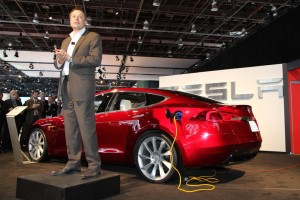
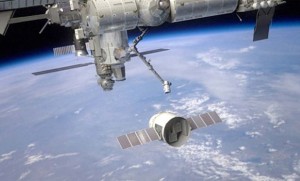
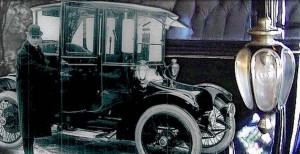
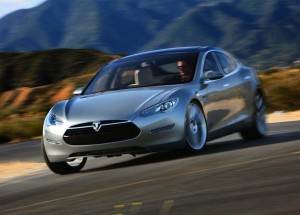
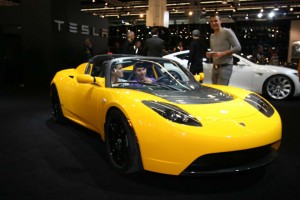
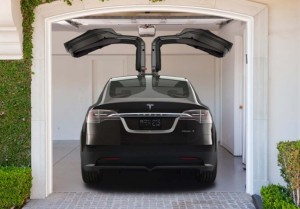
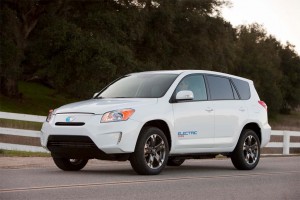
Ok. Can you share your calculations with us? You’ve always seemed to doubt the recharging times actual Tesla Roadster owners told you were possible. Now we at least have official numbers from Tesla and soon with have them from actual Model S owners.
“Charging times will vary, meanwhile. Using the most high-power Tesla system could cut times to as little as about 3 to 4 hours, according to the maker. That charger actually requires more current than the typical U.S. home could provide. With a more conventional charger that time could climb to as much as 18 hours, according to TheDetroitBureau.com’s calculations.”
Check out Tesla’s website:
http://www.teslamotors.com/models/charging#/calculator
I assume the more ‘conventional charger’ is a NEMA 14-30 at 24A (dryer outlet)? Most people will install a NEMA 14-50 and charge at up to 40A when buying a $90,000 car like this. This is valid even on the base 40kWh car with the single charger. At 24A, it’s 16 hours to completely recharge from empty. Again, you always seem to assume you arrive home empty each time. At the ‘conventional’ 40A, it drops to a little under 9 1/2 hours. If you can install a 100A line to your garage and buy the twin chargers and the Tesla HPC, that is 4 hours 45 min for a full 85 kWh recharge. While I disagree that that’s more power than the typical home can provide (I’ve talked with a contractor I know), anyone spending almost $90,000 on an electric car will likely have their electrical panel upgraded, don’t you think? Again, where did the 18 hours come from? Thanks.
Hi Paul,
I see your article was picked up by MSNBC as well. I really think painting a more realistic picture of the charging would be helpful and correcting your article and the MSNBC article would be great. I’m not sure how you came to the 18 hours since even on the lowest rated 240 plug it comes in at 16 hours max.
Something like
“While the Model S can be charged on the common 110V outlet, Tesla recommends against this. It is recommend you install a 50A outlet (NEMA 14-50 outlet) that delivers 40A allowing you to completely recharge the 85 kWh pack in 9 hours. On the normal NEMA 14-30 dryer outlet you may already have in your garage (at 24A), it would take 16 hours. The optional High Power Connector and second charger can bring that down to a little over 4 hours from empty but that requires a 100A line to your garage which may require electrical upgrades in some houses.
It should be noted that these recharging times are the outlet limits and assume you pull into your garage empty. If you only drove 40 miles on your 265 mile (EPA rating for the 85 kWh pack), it’d only take you an hour and a half to fully recharge. Telsa has a calculator on their website to give your cost and time to recharge for different distances.
http://www.teslamotors.com/models/charging#/calculator
“
PS: I am comfortable with the 18 hour figure at the long end for reason I earlier noted. In fact, you note 9 hours at 40A…so a 20A circuit, which I have been advised is common, especially in public, would indeed run to about 18 or longer. Of course, few folks will be down to 0 state, either. I appreciate you noting the 9 hour time on the 40. You may recall when charging was earlier debated here some months back, many were taking it as gospel all Model S buyers would go to 70A. Even the Tesla folks I then quoted indicated that wasn’t likely. Oh, and you note I make no reference to a situation where one might need 110 volts.
FYI, I spend a lot of time in a lot of battery vehicles of all form, and I have had more than a few occasions where I wind up short and in need of at least some power to get home. That happened recently when I went to tape an episode of Autoline Detroit driving a Focus Electric. Though the charge gauge indicated I should have had more than enough juice to get there and back (about 22 miles) the freeway driving meant I’d actually have run out halfway home. Two hours on their outside plug and I made it home but not with as much pad as I’d have liked.
Paul E.
I still don’t understand the 18 hours if you could spell it out in detail (what connection, how many volts and amps you are talking about). The NEMA 14-30 is actually 24A and that is where the 16 hours comes in. Anyone buying this car should get the 40A installed at home to make it worthwhile. The J1772 public chargers (adapter included) are actually 30A so that would be less than 16 hours, probably around 12 hours. I actually have over 12,000 miles in a Tesla Roadster now and their range indicator is very accurate. I’ve even done a few 210 mile trips and made it there with room to spare. The number you should quote as likely worst case scenario when charing in cities is probably the 30A number since there are more and more J1772 stations popping up but it is worth bringing up emergency 110V use.
I’m not sure which owners you were talking to but all of the Roadster owners I know and have spoken with on the TMC forum, even the ones with the HPC, almost never charge at more than 40A anyway. The most common use to charge at 70A is actually to charge other visiting Roadster owners up quickly and get them on their way. The Model S HPC can charge at 80A but you won’t find those likely in public. While the details aren’t out yet, I didn’t see you mention the planned Supercharger network that would give you a 80% charge in 45min. This rollout will likely be slow so the 30A public chargers and 40A campground outlets are the most common ones you’ll find when traveling.
Yes it would take about 60 hours to recharge the 85 kWh pack on a 110V so it’s emergency only basically. That would charge at about 3 miles of range an hour so enough to limp to a faster source. Thanks.
David